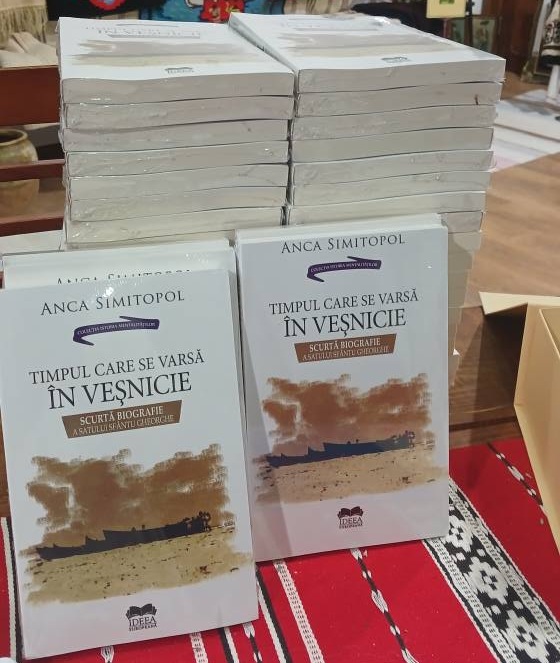Some books are read; others are inhabited. Timpul care se varsă în veșnicie (Time That Pours into Eternity) is one of those rare works that invites you to step fully inside its world. A world of “steppe, waters, and sky,” of windswept horizons and tidal rhythms, of memory woven into geography.
I first came across Timpul care se varsă în veșnicie when the Sfântu Gheorghe Museum, managed by my friend and the village’s vice-mayor, Mira Bălan, posted about its availability on social media (image in this blog comes from this social media post). I was astonished to learn that it had been published in 2022, yet had never surfaced during my extensive searches for my dissertation research. How this happened, I cannot say. Perhaps because the book does not appear in any academic search engine, nor on Amazon or Goodreads (I have since submitted a request to have it added to Goodreads). The discovery felt like finding a missing piece of a puzzle I had already been working on for years.
The narrative is at once a personal family chronicle and a micro-history of Sfântu Gheorghe, a village that seems to sit at “the end of the world and of time” yet remains deeply entwined with the wider currents of history. Through stories spanning generations, the book evokes a once-diverse cultural fabric, Ukrainians, Cossacks, Greeks, Romanians, fishermen, merchants, and housewives , and traces how it transformed over the 19th and 20th centuries into a more fragile, homogeneous present. One of its quiet powers lies in the conviction that the future is never empty space: “the future does not exist… it is created by the past and the present.” This perspective renders local history urgent and alive, a reminder that what comes next is already taking shape in today’s choices and yesterday’s legacies. The writing is lyrical yet precise, moving effortlessly between intimate moments and sweeping historical vistas. In one breath, we are by the hearth, listening to a family anecdote; in the next, we are drawn into geopolitical currents that link the Danube Delta to places as far away as France and Algeria. The effect is immersive. You can almost taste the salt in the air, feel the softness of river silt, and sense the weight of memory that lingers like mist.
Simitopol masterfully captures the intricate relationship between labor, tradition, and the natural world in the delta’s fishing communities. Without romanticizing, the author conveys the skill, endurance, and cooperation required to work with the river and the sea. Her account also reflects the intimate connection between livelihoods and environmental stewardship, where prosperity depends on respect for nature’s rhythms. It offers rich portrayals of the seasonal cycles that have long shaped life in Sfântu Gheorghe. These passages reveal the demands of fishing and the often-invisible roles of women who sustained households and contributed to physically demanding work while men were away. This is a theme that resonates deeply with my own research, which has shown how women’s unpaid labor and resilience form the backbone of community survival.
One of the delights of this book is its attention to the sensory world of the Delta : the tastes, smells, and textures that anchor its history in everyday life. Food traditions are described as culinary practices and an expressions of identity and continuity. Reading these passages instantly transported me back to the Hram in Sfântu Gheorghe this past May, where I shared storceag with villagers. Served in generous bowls, it was more than a meal: it was part of the celebration, a culinary ritual that affirmed belonging and continuity. In a time when sturgeon is rare and often replaced with other fish, sharing storceag felt like participating in a tradition that connects past and present, land and water, people and place.
One book passage that particularly resonated with me describes Grigore Antipa’s vision for the delta, a management system that treated nature and people as a single, interdependent whole, safeguarding ecological balance and incorporating the lifestyles, foodways, and knowledge of local communities into resource management. Reading this, I could not help but reflect on my own fieldwork over the past year, during which I have seen how far the delta has drifted from such an inclusive model. Today, the exclusion of local knowledge from governance is one of the deepest wounds felt by those who live here, compounding both environmental fragility and human insecurity. The author skillfully traces what happened after Antipa’s system was abandoned, leading to nature exploitation to the maximum, acting directly against ecological balance. This change led to a dramatic decline in fish stocks over time, a collapse from which production never recovered. It marked the loss of a sustainable management model and a worldview that recognized people and nature as parts of the same whole. Nowadays, this remains a critical conservation issue all over the world.
I found particularly poignant Simitopol’s observation that while there is international effort to protect endangered sturgeon species, no such campaigns exist to safeguard the “species” called fisherman, along with the traditions and knowledge that define a fishing village. Her words point to an uncomfortable truth I have also encountered in my doctoral research on climate change and human security in the Danube Delta: that conservation efforts too often focus on ecosystems as abstract entities, without equal regard for the human communities whose survival is bound to them. In Sfântu Gheorghe, many residents feel that their own existence is under threat, both from environmental change and economic marginalization and policies that exclude them from decisions about their land and waters. Simitopol goes further, noting that those who see their survival as precarious rarely support turning their home into a static museum for outsiders to admire. When one’s daily reality is reduced to scraping by, environmental ideals promoted from the outside, often with a moralizing tone, can seem detached, even hostile. This tension between ecological discourse and local priorities has been a recurrent theme in my research, as people expressed frustration at being portrayed as a problem to be managed rather than as rightful stewards of their own territory. It is a reminder that sustainable governance in the delta cannot be achieved without centering the voices, rights, and needs of the people who live there.
Importantly, the book also gives voice to the often-invisible labor of women in the delta. Simitopol describes how women’s days began at dawn and repeated without end, preserving vegetables and fruits for the “desert of winter,” maintaining households, and, in many cases, joining men in heavy labor such as cutting wood or harvesting reeds. This portrayal resonates deeply with my own research on women’s roles in Sfântu Gheorghe, where unpaid work, physical resilience, and the interweaving of domestic and economic labor form the backbone of community survival. This focus on women’s work is also at the heart of the book I am currently writing. My project documents the hard, unrecognized labor of women in Sfântu Gheorghe and explores their crucial role in both the ecosystem and the social fabric of the Delta. In my fieldwork, I have seen firsthand how women’s efforts sustain ouseholds and community resilience, bridging the gap between environmental stewardship and daily survival, yet these contributions remain largely invisible in official accounts and decision-making. As such, I found Simitopol’s book to be an invaluable companion. While my work focuses on contemporary lived experiences and gendered human security, examining how older women navigate environmental degradation, socio-economic marginalization, and shifting governance, Simitopol’s narrative roots the present in the deep soil of place and lineage. It provides the historical and emotional backdrop against which today’s stories, struggles, and resilience strategies unfold.
“Timpul care se varsă în veșnicie” is more than a book about a village: it is a meditation on belonging, time, and the delicate threads that connect us to the past. Simitopol closes with the reflection that “in the end, all these are old stories, which in the West happened long ago. This is how history advances, populations migrate, places are built and torn down, nothing is new and nothing is eternal under the sun.” Though simple, it carries the weight of universal truth. In the Danube Delta, this reality is felt with an almost painful clarity, villages that thrived just a generation ago now stand empty, houses collapse, and traditions fade. At the same time, life goes on, carrying with it a fragile yet persistent continuity. For anyone interested in the Danube Delta, micro-histories, or simply the art of storytelling, Simitopol’s work is to be read, re-read, and cherished.

